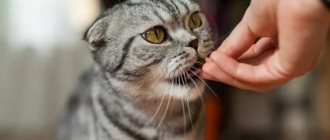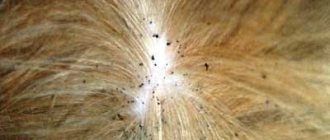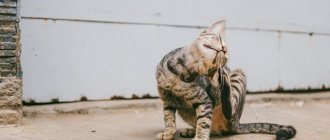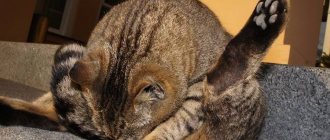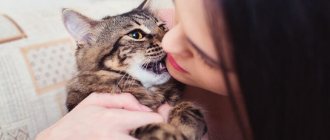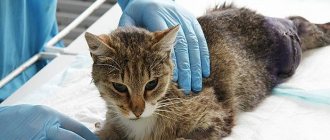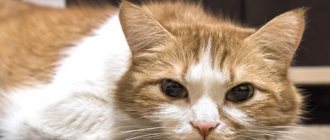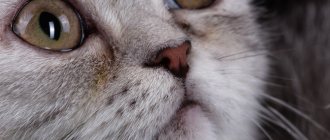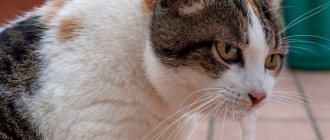If a cat licks under its tail no more than once a day, then this can be considered normal. Some pets pay increased attention to hygiene. But when this process becomes obsessive, licking may leave bald patches or even small wounds.
In such cases, the possibility of worms should be excluded first. Then they consider the option with fleas. Only after antiparasitic treatments can other causes be considered if symptoms persist.
Possible options
Every cat licks under its tail at least several times a week. This process should not be considered pathological, provided that the animal is regularly treated against fleas and ticks (at least once a month) and undergoes quarterly deworming.
If you add accompanying symptoms such as redness in the anus, discharge or the appearance of growths, it is recommended to exclude the following diseases:
Inflammation of the paraanal glands
It can form after eating bones, due to excess weight, soft food.
Prolonged diarrhea can also be a cause. The first signs of inflammation may include fidgeting on the butt, constant licking under the tail, and redness in the anus. The problem can be solved by cleaning (at least once every three months, if there is a predisposition to inflammation).
It is carried out by a veterinarian in a hospital setting . After cleaning, ointments (proctosedyl) and suppositories (ichthyol or sea buckthorn) are prescribed. A change of food and increased hygiene are also indicated.
Fleas
They can cause itching in different parts of the body. But most often bites occur on the base of the tail and stomach. Therefore, if a cat licks under its tail, behaves restlessly, tries to chew out fur, or tears itself with its paw until it bleeds, then flea treatment should be carried out. The fact that your pet does not leave the house is not 100% protection against parasites.
The owner himself can bring them on clothes or the soles of shoes. Fleas are not dangerous to humans (they do not parasitize the skin), but in some cases they can bite. All animals are treated, regardless of the presence of symptoms.
The most effective drugs are Stronghold and Frontline. They are produced in the form of drops, which are evenly applied to the withers so that the animal cannot lick the drug. It is recommended to perform this procedure at least once a month.
Worms
The most common reason why a cat may lick under its tail frequently.
Just like with fleas, an animal does not have to go outside to pick up parasites. He may develop them after being bitten by mosquitoes, mosquitoes, or fleas. Also at risk are pets whose diet contains raw meat and fish. Well, we cannot exclude the possibility that parasite eggs may enter the apartment on the soles of the shoes of the owner or his guests.
The first signs of worms are itching in the anus, due to which the cat can ride on its butt on the floor. Licking and gnawing of fur in this area also indicate discomfort caused by parasites. Diarrhea, vomiting and increased appetite (or, conversely, complete refusal to eat) can be considered concomitant symptoms of helminthic infestation.
Veterinarians recommend starting to worm animals from 3-4 weeks of age. As preparations, you can use tablets, suspensions or drops on the withers. Of the tablets, Drontal and Milbemax are considered the most effective. They can even be given in crushed form, adding to food. Some manufacturers offer meat-flavored tablets, since many pets flatly refuse to undergo deworming.
Injury
This option cannot be ruled out. A pet can injure the anal area while climbing trees or after playing or fighting with other animals. Even a small scratch can cause significant discomfort. Because of this, a cat can constantly lick under its tail until it becomes bald.
In such cases, it is recommended to carry out antiseptic treatment of the affected area until complete healing. And limit the animal's access to the wound using a special medical cap.
Neoplasm
Unfortunately, this option should also be considered, especially if the animal is over 10 years old, it has been treated for parasites and there are no visible injuries in the anal area. The tumor can irritate the intestines, which explains the pet's restless behavior. The cat constantly licks under its tail, refuses to eat, and suffers from constipation.
If necessary, the doctor performs diagnostic laparoscopy, during which cells are taken from the formation for histological examination. Depending on the type (sarcoma, lymphoma) of the tumor, treatment is selected (chemotherapy, surgical excision).
Unfortunately, with tumors in the intestine, the prognosis is always cautious, even if the operation is successful and there are no metastases.
Finally, I would like to remind you that if a cat licks under its tail after giving birth, this may be an alarming signal for the development of pyometra, which can “burn” the animal in a few days. Therefore, in the postoperative period this symptom should not be ignored under any circumstances.
There are situations when the natural process of grooming cats can become obsessive. If a cat licks under its tail for an excessively long time and frequently, this may be a signal that there is a problem.
You should not ignore the fact that a pet tends to constantly lick itself in all places. It's possible that she's just in heat and the cat is bleeding from under her tail, however, there is a possibility that the cat has sores on her tail or something more serious. A clear sign of increased licking can be frequent regurgitation of hairballs.
This means it's time to take some action. If it is not possible to figure it out on your own, then it is advisable to show your pet to a veterinarian. After all, only a specialist who works in this field can understand such a situation, and who can identify the true cause and choose the right treatment.
This is a completely natural process that helps cleanse the wound. An animal cannot take care of itself in any other way. But such actions may be undesirable if the damage site is treated with some kind of agent or stitches are applied. To prevent such licking, the pet must limit access to the sore spot.
Prevention
Adviсe:
- Regular preventive maintenance helps prevent illness, the living area is cleaned, the floor is washed, dust is removed, and the cat's bed is always washed.
- The bowl is kept clean and the drinking water is fresh.
- Ears are regularly cleaned and treated with antibacterial agents.
- Veterinarians advise using only high-quality food.
- Communication with other animals is limited.
If the kitten is itchy and there are no fleas, it will be examined by a veterinarian.
Preventive remedies for worms:
- Cestal cat is an anthelmintic medicine taken orally, once. The tablet is placed on the tongue or dissolved in water.
- Dirofen in gel or tablet form is taken in the morning from three weeks of age.
- Milbimax for young and adult animals, the dosage is determined by veterinarians.
Sedatives:
- Fospasim is taken for stress during moving, aggressive behavior, and fears. It is produced in the form of tablets and solution for injection.
- Bach drops are often given to animals at shows, dissolved in water, and injected into the mouth with a syringe.
Immunostimulants and restorative drugs:
- Gamavit contains many useful microelements, vitamins, stimulates metabolism, increases the chances of survival in weak individuals. Injections are given under the skin and into the muscle.
- Catozal is prescribed for problems with metabolism, disorders of the reproductive system, prevention of infertility, and exhaustion of the body. The medicine tones and normalizes metabolic processes.
- Imunofan is used to strengthen the body's protective functions and treat respiratory diseases; it is injected every 3 months.
- Ringer-Locke for dehydration, bruising, for cleaning ears and eyes, a general strengthening drug.
- Evinton treats viruses, stimulates the immune system, and is prescribed for rhinotracheitis, gastroenteritis, complications after vaccinations, and allergies.
- Cycloferon for plague, enteritis, calcevirosis, rhinotracheitis, chlamydia.
Medicines that help with injuries:
- Traumatin is injected into the muscle and under the skin, used for fractures, dislocations, skin damage, relieves pain during childbirth, helps get rid of shock, stops bleeding, stimulates healing.
- Monclavit is an extended-spectrum antiseptic for topical use that leaves no residue on the coat.
Medicines used during childbirth:
- Mastomethrin for inflammation and problems with the reproductive system, postpartum complications, normalizes uterine contractions, destroys pathogenic microflora, and is not used during pregnancy.
- Calcium borogluconate for eclampsia, shock, rickets, before the injection it warms up to 39 degrees, causes pain.
- Oxytocin is a hormonal substance that is injected carefully and is not used before childbirth.
Anthelmintics are used on the recommendation of a veterinarian every 3-4 months.
Licking due to stress
Frequent licking is not always associated with the physiological health of the animal. Perhaps some psychological aspect plays a role in such a situation. Cats like their lives to go on without much change, so any innovation can cause them anxiety. Redevelopment of the house, the appearance of new pets, change of regime and similar innovations cause emotional distress in cats.
Solving a licking problem requires a lot of patience and time, regardless of whether the cause is physiological or psychological. If you provide proper care and attention, then after some time the pet’s coat will be restored, and life will return to normal.
Did you like the article? Subscribe to the channel to stay up to date with the most interesting materials
Every cat lover has asked himself why cats lick themselves. This is a useful hygiene procedure for furry pets. The cat licks itself to remove dirt and loose hair from its fur. Licking is necessary for proper thermoregulation of the body and maintaining health. But there are situations when a cat constantly licks itself. This is often a sign of serious illness.
Pathological causes of constant licking
This phenomenon can be directly related to some diseases and abnormalities in the animal’s body, namely:
- Gastrointestinal disorders . Excessive salivation occurs due to severe forms of microflora disturbance in the intestines, chronic gastritis or heartburn. Licking and swallowing helps relieve the condition, but only for a very short time.
- Dental problems . Pets over the age of 5 years may suffer from the development of caries, periodontal disease and other abnormalities in the oral cavity. The copious secretion of saliva helps fight pathogens.
- Leftover food . Stuck pieces of food cause some discomfort. In order to get rid of foreign inclusions, a large amount of saliva begins to be released.
- Changing the usual food . New brands may cause an allergic reaction, including excessive saliva flow. Other symptoms include redness and swelling of the eyes, and watery eyes.
If constant licking is accompanied by other suspicious symptoms, you should contact a veterinarian.
In some cases, only timely assistance can save the life of a pet.
A cat constantly licks its tail
If a cat often licks under its tail, this should alert the owner. Various reasons force males and females to lick this place.
If a cat often licks its tail, then this is:
- inflammation of the preputial sac;
- inflammation, injury or cancer of the foreskin;
- urethral diseases (stones, trauma, neoplasm);
- bladder diseases (infections, tumors, stones);
If a cat constantly licks itself, then this should alert the owner
- prostate diseases (prostatitis, tumor, abscess);
- urinary incontinence;
- dysfunction of the sphincter;
- bleeding (coagulopathy) and thrombocytopenia due to rat poison poisoning.
For your information! Cats have a fatty lubricant in their skin that contains cholesterol, which in the sun is converted into vitamin D. By licking, the cat distributes this substance over the entire surface of the body.
Females often lick themselves before and after childbirth, and this is not a pathology. But there are a number of situations where excessive licking is a symptom of illness.
If a cat constantly licks its tail, then this is:
- urinary tract infections;
- inflammation of the uterus and vaginitis;
- tumors of the genitourinary system;
- injury or foreign body in the urinary tract or vagina;
- blood clotting (coagulation) and thrombocytopenia in case of poisoning with rat poison;
- urinary incontinence, sphincter dysfunction;
- retained placenta or death of the kitten during childbirth.
Important! If a cat constantly licks the area near the tail, then the owner needs to pay attention to the discharge from the pet’s genitals. These symptoms will help the veterinarian make the correct diagnosis and treat your pet.
If your cat is constantly licking his tail, you need to take a closer look at other symptoms.
Allergic reactions to foods
The most common cause of itching and skin irritation in cats is food allergies. A cat can become ill from both natural food (for example, meat) and special industrial ones. Popular cheap foods (Kitecat, Whiskas, etc.) cause allergies in many people. It is advisable to choose premium hypoallergenic ones, which are sold only in pet stores.
For your information! Most often, allergies are caused by food proteins, which are found in large quantities in chicken meat, cow's milk and a number of other products.
If a veterinarian has discovered a food allergy in a cat, you need to exclude the dangerous product from the diet and prescribe the correct diet for your pet.
A cat food allergy often manifests itself as inflammation on the skin.
Presence of parasites in the body
External and internal parasites often cause cats to scratch and lick themselves. Fleas, ticks, and lice eaters are especially dangerous for furry pets. They bite the cat and drink its blood, and this leads to the development of allergies and decreased immunity. Ear mites often cause otitis media, a serious disease that can lead to serious complications.
If a cat has parasites in its fur, it will lick them frequently and feverishly. Small blood-sucking insects greatly irritate your pet's delicate skin. Parasites can be easily removed with flea treatment, but you should consult your veterinarian and check your cat for other diseases.
Damage to the skin on the tail
Any owner knows why cats lick themselves. If your cat's tail has wounds or any other damage, it can cause itching and irritation. Having received an injury, the cat begins to lick the sore spot in order to heal it. This way the animals lick any sores. To prevent your cat from doing this, you can put an Elizabethan collar on it.
Unpleasant habit after castration
A situation often arises when a cat licks itself after castration. Every veterinarian knows what to do in this case. He must examine the pet and check for allergies, infections and inflammatory processes.
But is it possible for a cat to lick itself after castration, the answer will be clear - it’s impossible, because the pet can lick the post-operative suture and cause an infection. If the owner overlooked it, and after castration the cat licked a wound under its tail, this requires urgent treatment and re-suturing. To prevent this from happening, a medical collar is put on the cat, which must be worn for 10 days after the operation. The suture should be treated with special medications prescribed by a doctor.
Veterinarian advice
It is no secret that many parasites and viruses are transmitted from one animal to another, through the hands of people, but you should not be afraid and limit the freedom of a cat. Of course, there is no need to throw your pet into a pack of stray cats, but letting it out for a walk on the balcony or in the country is quite possible. Like any animal, cats also need fresh air and sun. It is enough just to keep the animal clean and carry out timely antiparasitic treatment.
Do not forget about a proper and balanced diet, which is also the key to your pet’s health. If he has a strong immune system, then no infection will be scary to him. Do not feed prohibited foods, sweets, salty and smoked foods. All this can cause or provoke the occurrence of food allergies. Pay attention to when your pet licks.
And finally, the last piece of advice is love and affection. Remember that your cat is a living creature that needs your care and attention. A change of owner or a change in your behavior can cause stress in your pet. And stress, as you know, is the first step to illness. If you want to pet an animal, but it is nervous and wags its tail, it is better to leave it alone, do not squeeze or pick it up without the desire of the pet itself. Remember that he also has the right to peace and rest.
Sorry, there are no surveys available at this time.
Reasons why a cat licks its fur in the absence of parasites
In many cases, a cat constantly licks itself not because of parasites, but for other reasons. The most common of them is stress. Compulsive licking in cats can be compared to the human habit of biting nails. This indicates that the cat is starting to get very nervous. The owner must eliminate the cause of the pet’s emotional distress.
Other reasons why a cat constantly licks itself are fungal diseases (lichen), allergies, dermatitis, otitis, and inflammation. The doctor must make an accurate diagnosis and prescribe adequate treatment.
Lichen
Ringworm, or dermatophytosis, is a fungal infection of the skin and fur. The causative agents are fungi of the genus Microsporum or Trichophyton. They affect the roots of actively growing hairs. Characteristic bald patches appear on the head, tail, ears, and paws, and the skin peels off. In the affected areas, the hair can quickly fall out, and the cat begins to go bald.
This disease is very contagious, but is easily treated, does not pose a threat to the life of an animal or a person and does not lead to serious health consequences. Very often, cats with reduced immunity and small kittens get deprived of the disease. The main symptom of lichen is round bald spots covered with scales. If the disease is not treated, then over time the fungi will affect other areas of the coat.
Note! The itching associated with ringworm in cats is usually not severe. If it is accompanied by a skin disease of a bacterial nature, the itching may intensify. Then the cat will constantly itch and lick itself. Scars or scabs may form on the skin.
Ringworm in cats is diagnosed at a veterinary clinic. The doctor makes a hole with a Wood's lamp, takes a scraping from the skin, analyzes wool hairs and inoculates fungi on a nutrient medium. You will also need a blood test to check for infections. Once the diagnosis is confirmed, treatment should begin immediately.
For lichen, the course of treatment lasts a long time (about 3 weeks). In severe cases, recovery takes several months. The pet is prescribed medications for internal and external use. The veterinarian can prescribe medications such as microderm, vakderm, fungin, Yam BK ointment, etc. A sick pet must be isolated from other animals and provided with abundant and nutritious food, rich in vitamins and beneficial microelements. Despite the fact that people do not always become infected with shingles from a sick cat, it is necessary to thoroughly clean and disinfect the apartment.
Vaccinations against lichen are made with the Polivac TM or Vakderm-F vaccines. Vaccination is carried out twice with an interval of 2 weeks.
For your information! If the affected hair has stopped growing, it will not be affected by lichen. Therefore, cats often recover suddenly.
Dermatitis
Dermatitis refers to a whole group of inflammatory skin diseases in cats. Even a calm and affectionate animal becomes aggressive and restless. Reddened areas appear on your pet's skin, and sometimes a rash appears on them. The affected parts of the skin are very itchy and itchy, which is why the cat may often itch, lick, and even gnaw out fur and skin. Sore spots are hot to the touch. The kitten may meow loudly and lick its lips frequently. Then comes the next stage of the disease, when the skin peels off and becomes wrinkled. Purulent lesions may appear.
Causes of dermatitis in cats:
- allergies to food (preservatives and dyes);
- allergies to shampoos and other chemicals;
- infestation with fleas, lice eaters, ticks, worms and other parasites;
- burn or hypothermia;
- a scratch or bite on the skin;
- infection of already damaged skin by bacteria, development of inflammation;
- individual intolerance to certain drugs, especially oxytetracycline.
In most cases, the trigger for dermatitis is an allergy of any origin. Your cat may be allergic to dust, fungus, or food protein. If a cat's fur is brushed too vigorously, the skin may become damaged and dermatitis may occur.
Important! Dermatitis is dangerous because it often becomes chronic. Symptoms will come and go, and your cat's health will worsen. Deep, non-healing wounds may occur on the skin. Sometimes the cat licks itself and rubs the skin until it bleeds.
If you suspect dermatitis in a cat, you should not hesitate to contact a veterinarian. Only a doctor can find out the cause of the disease and prescribe treatment. First of all, you need to get rid of the allergen that triggered the development of dermatitis. To do this, you will have to replace food, shampoo and other household items. The veterinarian will help you choose the appropriate food.
Dermatitis in a cat
Endocrine system disorders
Excessive licking may be a sign of endocrine dysfunction in cats. The veterinarian performs many diagnostic tests to find out what exactly is causing these symptoms. Knowing the cause and mechanism of development of hormonal imbalance, the doctor will prescribe suitable treatment for your pet.
Otitis is an inflammation of the middle ear in cats, often leading to dangerous complications. Pets suffer from otitis media much more often than people. If the cat begins to scratch its ear frequently and intensely and shakes its head, otitis may be suspected. The skin on the inside of the ear appears irritated, red and swollen. Treatment must be started immediately, otherwise purulent otitis may develop.
For your information! In the purulent form of the disease, a thick, dark brown liquid with an unpleasant odor is released from the ear. This disease causes severe pain to the cat. In severe cases, inflammation of the facial nerve may occur, then the pet's ear, eyelid or lip sag. Further inflammation affects the vestibular apparatus and brain. Because of this, the cat may die or remain disabled.
Otitis media in cats can be caused by parasites (especially fleas and ticks), bacteria, fungi, allergies, trauma, and foreign bodies in the ear. Hypothermia can also cause otitis media. Therefore, if the cat is cold or caught in the rain, it must be warmed up and kept in a warm room. Water that gets into the ears is very dangerous for your pet.
What is overgrooming in cats?
Overgrooming in cats is a rather poorly studied pathology, characterized by excessive licking of certain areas of the body, as a result of which the hair in these places becomes thinner, and then bald spots are formed - areas of open skin, sometimes with the presence of wounds.
Cat owners need to know that overgrooming often occurs in animals due to psychological reasons.
With this disease, the cat can not only lick, but also bite the skin so that wounds appear. If you do not treat your pet, painful licking can even lead to the amputation of a part of the body.
Cat owners need to know that overgrooming often occurs in animals due to psychological reasons, usually associated with the cat experiencing stress.
Due to the current lack of serious, in-depth research into the causes and treatment of the disease, adjusting the behavior of cats is a long process , in parallel with which the pet’s skin is also treated.
What parts of the body are at risk?
Completely different areas of the body can be overgroomed, but most often cats lick:
- stomach;
- the inside of the hind legs;
- front legs;
- underbelly;
- lateral parts of the body.
Treatment of overgrooming in cats
Important! Only a specialist can cure dangerous licking of a cat’s fur.
The veterinarian, after examination and some research carried out on the basis of tests, can determine the root cause of the disease. If overgrooming occurs as a result of stress, correction of the animal’s behavior is prescribed by a zoopsychologist.
If the disease is caused by an allergy, then after tests and a conversation with the owner, this product is excluded from the animal’s diet. In especially dangerous cases, when the cause of the disease is infection of the cat’s body with parasites, the doctor prescribes antihistamine therapy.
Diagnostic measures
To correctly determine the reason why a cat licks itself too often, the veterinarian performs a number of diagnostic procedures. To diagnose lichen, a Wood's lamp is used. After this, the doctor takes scrapings from the sore spot and damaged hairs from the cat. Then the skin sample taken is inoculated onto a nutrient medium. Additionally, blood is taken from the cat to test for infections. All procedures together will help you find out the cause of the disease and heal your pet from the disease.
A cat's fur is examined with a Wood's lamp to diagnose lichen.
Symptomatic treatment
You need to start by finding out the causes of the phenomenon. If these are medical problems, then they need to be addressed with the help of a veterinarian. You should consult a doctor if your animal regurgitates hairballs too often, licks itself until bald patches form, and various rashes and scratches appear on the skin.
The veterinarian will assess the cat’s condition and conduct the necessary examinations. For example, in case of receding hairline and scratching until it bleeds, a specialist will definitely do a scraping and take a blood and urine test. If internal pathologies are suspected, the specialist will conduct an ultrasound and computed tomography.
Once the diagnosis is made, the veterinarian will prescribe treatment. If you strictly follow all the veterinarian’s recommendations, then recovery will come quickly, and intense licking will pass.
Therapeutic measures
Any skin, parasitic or endocrine diseases should be treated immediately. The duration and method of treatment depends on the cause of the disease. If you have an allergy, you need to adjust your diet and remove the allergen. Ringworm is treated with antifungal ointments and tablets. For inflammatory and infectious diseases, a course of treatment with antibiotics and anti-inflammatory drugs is prescribed. Regardless of the cause of the disease, treatment always takes a long time: from 3 weeks to 2 months. It is necessary not only to help the cat stop itching, but also to completely eliminate the infection.
Treatment is prescribed depending on the cause of the disease
Is it dangerous?
Frequent licking of a pet's fur should alert the owner. The following symptoms indicate the development of overgrooming:
- the appearance of bald patches in different parts of the body;
- areas with sparse hairs that often break;
- deterioration of the coat condition;
- signs of allergies;
- scratches, ulcers and other wounds on the skin of a cat that take a long time to heal;
- lethargy, apathy and reluctance to eat.
If the problem is neglected, it threatens to affect more areas on the animal’s body.
If you do not carry out treatment in time and do not get rid of the problem in which the cat licks the fur down to the skin, then there is a high probability of multiple bald spots appearing, which will deteriorate the appearance of the pet. When overgrooming, there is a risk of infection in the wounds, as a result of which an acute inflammatory process progresses in the deep structures of the epidermis. When a cat not only injures the skin through frequent licking, but also chews it out in pieces, necrotic lesions appear. Overgrooming is a common cause of disrupted natural hair replacement process.
Preventive actions
Fungal and bacterial infections can be prevented by practicing good hygiene. Special medications and treatments will help protect your cat from lichen, dermatitis, otitis media and other diseases. For prevention, you need to regularly treat your pet against fleas, ticks and fungi, and also wash the bowl and tray with disinfectants. Bathing with a special shampoo is beneficial for cats. This procedure only needs to be done once a year.
Important! After treating a kitten with anti-flea or anti-fungal products, the animal should not be bathed. It is forbidden to wet the area where the medicine was applied.
The cat licks itself to help itself
Sanitizing the tray and bowl
All items belonging to the cat - bowl, tray, toys, etc. - must be regularly washed and treated with disinfectants. This will protect your pet from infectious, fungal, viral and other diseases. The bowl can be washed with regular dishwashing detergent. Usually fungus does not form on a cat's bowl, most often in the tray. It is advisable to treat it with any antifungal spray against lichen. Additionally, you can treat the tray with camphor alcohol, which not only cleans and disinfects the surface, but also eliminates unpleasant odors.
The bowl and tray should be washed and disinfected regularly
Special flea products
There are many treatments available at pet stores for fleas and other external parasites. They are available in the form of drops on the withers, sprays and collars. It is advisable to treat the cat with drops on the withers; this is the most effective remedy. The room can be sprayed with flea spray. Flea collars are not very effective. It does not destroy insects, but only repels them. A collar can only be put on a cat if it has recently been treated for fleas. Flea drops such as Leopard, Frontline, Advantage, Inspector, and Bolfo spray are very effective.
Flea remedies
Symptomatic diet and procedures
The best treatment is prevention. Therefore, to prevent the occurrence of this symptom, it is important:
- Regularly wash the cat's food and drink bowls, clean the cat's house, bedding and carpets indoors.
- Regularly inspect your cat's fur, comb it out and remove tangles.
- Clean your cat's ears and keep them clean.
- Supplement the daily diet with vitamins and microelements, especially if the cat has recently been ill and its body is weakened.
- Do not allow your pet to come into contact with dirty street animals.
- Give your pet enough attention and don’t forget to caress her.
You can help the animal solve psychological problems on your own. There is no need to lock your cat in a small room. If you are going to the country for the summer, take your pet’s house with you. After moving or adding another animal to your home, try to spend a little more time with your pet at first. If you help a cat realize its predator or hunter instinct by playing with it for at least 20 minutes, it will be easier for the animal to cope with stress.
Cats love platforms raised above floor level. They consider them a good place to retreat in case of danger. They can sit on these sites, experiencing moral discomfort. It’s good if you can equip a pet house on one of the sites. If necessary, the cat can retreat and survive stress in a secluded place.
Diagnosis of the disease
If a cat constantly licks its tail, then it is worth talking about the presence of a disease that can only be determined by a veterinarian. The owner, turning to a veterinary clinic for help, will certainly be faced with the following procedures:
- Submission of general urine and blood tests, as well as biochemical blood tests,
- Submitting urine for bacterial culture (this action is necessary for specialists to exclude the presence of an infection in a pet located in the urinary tract area),
- Carrying out cytology and other bacterial studies,
- If bloody discharge appears, the animal will have to undergo coagulation; this procedure is also necessary to identify the cause related to blood clotting disorders,
- X-ray of the abdominal cavity (helps to identify the presence of an inflammatory process, for example, prostate disorders),
- Ultrasound of the abdominal cavity.
Anal gland problem
Cats quite often have problems associated with the excretory system . If your cat has a wound under his tail that is not related to injury, you should consult a veterinarian. It can be caused by a blockage of the sebaceous glands near the anus.
The disease is called inflammation of the paraanal glands. The secretion from the glands spreads throughout the body and leads to inflammation of neighboring tissues. An abscess appears. Left untreated, it can make it difficult for your cat to go to the toilet. Then blood poisoning occurs.
Constipation
When defecation is difficult or absent, the cat begins to lick the anus, believing that this will help her.
Stool retention occurs for the following reasons:
- Unbalanced diet. If you give your cat only animal ingredients that do not contain dietary fiber, peristalsis stops. In such cases, switching to professional food of at least premium class, which contains fiber, helps. With a natural type of feeding, the situation is corrected by the inclusion of vegetables in the diet. If the desired result is not achieved, use oil laxatives or seek veterinary help.
- Blockage with hairballs. Develops in long-haired pets with natural feeding. They use Malt paste, if it does not help, go to the clinic.
- Intussusception: One part of the intestine enters another due to an unsuccessful jump or push.
- Blockage by helminths - eliminated in the presence of a veterinarian with the help of anthelmintics, since intoxication with waste products of parasites or intestinal rupture cannot be ruled out.
- Postoperative constipation: contact the surgeon and follow his orders.
- Neoplasms are identified by chance during a clinical examination. Your veterinarian may suggest symptomatic treatment, surgery, or euthanasia.
How it develops
The mechanism of development of the disease is simple:
- disruption of the natural outflow of secretions leads to overflow of the sinuses;
- the liquid inside thickens, leading to inflammation and severe itching;
- the irritating factor promotes the active growth of microflora;
- the affected area increases, which ultimately leads to the formation of an abscess and a breakthrough of the walls of the gland;
- At this point, the body temperature may rise and the general condition of the cat may deteriorate significantly.
It is clear that it is impossible to let the disease progress to such a state, especially since this can lead to the death of the pet! It is also worth knowing: purulent inflammation of the paraanal glands is practically untreatable, and the disease takes a chronic course.
Urogenital pathologies
There are the following diseases of the genitourinary organs, in which the cat intensively licks under the tail:
- cystitis;
- urolithiasis disease;
- endometritis and pyometra
Cystitis
Inflammation of the bladder due to hypothermia, unbalanced nutrition, infection of the genitals and urinary tract.
In addition to licking, it manifests itself with the following symptoms:
- urine first turns yellow, then becomes brown and foul-smelling;
- emptying of the bladder becomes more frequent, little fluid is released;
- the cat meows pitifully;
- leaves puddles everywhere.
Treatment consists of drinking plenty of fluids, fasting, rest and comfort. The veterinarian prescribes antimicrobial, immunomodulatory, and painkillers. In acute cases, the drug Stop-cystitis is prescribed. If the disease has reached a chronic stage, the herbal medicine Cat Erwin is used to relieve complications.
Prevention consists of proper nutrition, regular vaccinations, deworming, prevention of drafts and hypothermia
Urolithiasis disease
The disease is manifested by precipitation of urinary salts and injury to the urethra and ureters. The main reason is an unbalanced diet. Neutered men suffer most often. Pets that are overweight and do not exercise much are predisposed to the disease.
Clinical symptoms resemble cystitis, however, vomiting, refusal to feed, and convulsions are added. When the lumen of the urethra is blocked by stones, anuria develops, in which urine is not excreted. Acute attacks are relieved in a clinical setting. Conservative treatment and prevention include diet therapy. Veterinary feed is used.
Endometritis and pyometra
Inflammation of the uterine mucosa occurs as a result of pathological lambing or false pregnancy. A special role in the development of the disease is played by the uncontrolled use of hormonal contraceptives to disrupt estrus and unwanted pregnancy.
If conservative treatment is untimely or unsuccessful, the cervix closes and pyometra develops, a life-threatening condition. The optimal treatment is castration.
How to treat?
Constant licking of fur down to the epidermis is not normal and requires therapeutic measures. It is impossible to eliminate the problem without finding out its original source. To do this, contact a veterinarian who will conduct a diagnosis and select medications if necessary. Drug treatment is required for atopic dermatitis. To eliminate itching, the following medications are prescribed for cats:
When a pet licks its fur to the skin under the influence of stress factors, the cat needs to be provided with peace and surrounded with care. If pathological licking occurs against the background of an allergic reaction, then the influence of the irritant on the cat’s body is immediately excluded. If the violation does not go away, then additional antihistamines are prescribed. To combat the problem caused by small parasites, pet hair is treated. For this purpose, you can use antiparasitic drops, tablets or sprays.
